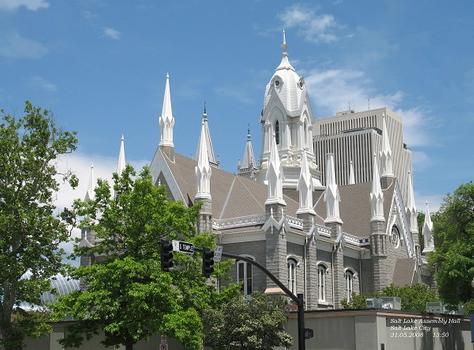General Information
Project Type
| Function / usage: |
Religious building |
|---|
Location
| Location: |
Salt Lake City, Salt Lake County, Utah, USA |
|---|---|
| Coordinates: | 40° 46' 10.92" N 111° 53' 34.80" W |
Technical Information
There currently is no technical data available.
Excerpt from Wikipedia
The Salt Lake Assembly Hall is one of the buildings owned by The Church of Jesus Christ of Latter-day Saints on the southwest corner of Temple Square in Salt Lake City, Utah. It has seating capacity for an audience of approximately 1,400 people.
Design
The Salt Lake Assembly Hall is a Victorian Gothic congregation hall. Rough granite walls are laid out in cruciform style making the hall's exterior look like a small gothic cathedral. Twenty-four spires mark the perimeter of the building's footprint and a tower rises from the intersection of the floor plan's apparent crucifix. The cruciform layout is complemented by Stars of David circumscribed high above each entrance. These symbolize an LDS perception that they are a re-gathering of Biblical Tribes of Israel.
However, the deceptively Gothic exterior conceals a more modern interior lacking vaulted ceilings.
Although built of quartz monzonite rock from the same quarry as the Salt Lake City Temple, the Assembly Hall's unhewn exterior looks much different. The stones for the Assembly Hall were not cut as exactingly as the Temple's. This accounts for the building's dark, rough texture and the broader masonry joints between stones.
Seagull Monument sits directly in front of the building to the east.
History
Construction of the Assembly Hall began on August 11, 1877. Building began on the southwest corner of Temple Square on the site of what was called the "Old Tabernacle," razed earlier that year. The old structure, an adobe building determined by the Church to be inadequate, was built in 1852 and seated 2500. The "Old Tabernacle" is not to be confused with the still-extant Salt Lake Tabernacle, built in 1867. The domed Tabernacle sits directly north of the Assembly Hall.
During the first two years of construction, the Assembly Hall was confusingly called the "new tabernacle." John Taylor, then president of the church, cleared up the confusion by naming it the "Salt Lake Assembly Hall" in 1879.
Obed Taylor was commissioned as architect, and designed the structure in Victorian Gothic style, which was popular at the time. Using mostly discarded granite stone from the ongoing construction of the Salt Lake Temple, builder Henry Grow completed construction in 1882 at a total cost of $90,000.
After the Tabernacle, the Assembly Hall was the second permanent structure completed on Temple Square. It has been modified several times since completion, however. A four-foot flying-angel weather vane like one that topped the older Nauvoo Temple in Nauvoo, Illinois was removed. Additionally, the original ceiling murals depicting ancient and modern prophets in the LDS Church were painted over.
The most comprehensive renovations occurred from 1979 to 1983 to correct structural weaknesses in the building's tower and roof trusses. While rebuilding the tower, each of the Hall's 24 spires were replaced with fiberglass moldings. Additionally, all the softwood benches were refinished, and Robert L. Sipe Organbuilders installed a new 3,489 pipe organ with a "German accent." The renovations also included creation of rehearsal studios in the building's basement. These spaces contain three practice organs, of 2-3 manuals each, built by the Austin, Kenneth Coulter, and Casavant Frères organ companies, as well as a one-manual harpsichord built in 1981 by William Dowd. Acoustics in the building were enhanced by installing hundreds of small speakers.
Currently, the Assembly Hall hosts occasional free weekend music concerts and is filled as overflow for the Church's Annual and Semiannual General Conferences.
Text imported from Wikipedia article "Salt Lake Assembly Hall" and modified on July 23, 2019 according to the CC-BY-SA 4.0 International license.
Participants
Relevant Web Sites
- About this
data sheet - Structure-ID
20025075 - Published on:
14/11/2006 - Last updated on:
30/07/2014





